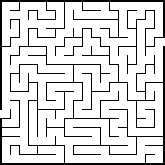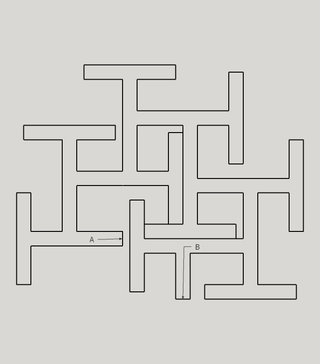
The hippocampus is a major component of the brain of humans and other vertebrates. Humans and other mammals have two hippocampi, one in each side of the brain. The hippocampus is part of the limbic system, and plays important roles in the consolidation of information from short-term memory to long-term memory, and in spatial memory that enables navigation. The hippocampus is located in the allocortex, with neural projections into the neocortex in humans, as well as primates. The hippocampus, as the medial pallium, is a structure found in all vertebrates. In humans, it contains two main interlocking parts: the hippocampus proper, and the dentate gyrus.

In neuroscience, long-term potentiation (LTP) is a persistent strengthening of synapses based on recent patterns of activity. These are patterns of synaptic activity that produce a long-lasting increase in signal transmission between two neurons. The opposite of LTP is long-term depression, which produces a long-lasting decrease in synaptic strength.

In cognitive psychology and neuroscience, spatial memory is a form of memory responsible for the recording and recovery of information needed to plan a course to a location and to recall the location of an object or the occurrence of an event. Spatial memory is necessary for orientation in space. Spatial memory can also be divided into egocentric and allocentric spatial memory. A person's spatial memory is required to navigate around a familiar city. A rat's spatial memory is needed to learn the location of food at the end of a maze. In both humans and animals, spatial memories are summarized as a cognitive map.

The Morris water navigation task, also known as the Morris water maze, is a behavioral procedure mostly used with rodents. It is widely used in behavioral neuroscience to study spatial learning and memory. It enables learning, memory, and spatial working to be studied with great accuracy, and can also be used to assess damage to particular cortical regions of the brain. It is used by neuroscientists to measure the effect of neurocognitive disorders on spatial learning and possible neural treatments, to test the effect of lesions to the brain in areas concerned with memory, and to study how age influences cognitive function and spatial learning. The task is also used as a tool to study drug-abuse, neural systems, neurotransmitters, and brain development.

The radial arm maze was designed by Olton and Samuelson in 1976 to measure spatial learning and memory in rats. The original apparatus consists of eight equidistantly spaced arms, each about 4 feet long, and all radiating from a small circular central platform. At the end of each arm there is a food site, the contents of which are not visible from the central platform.

A place cell is a kind of pyramidal neuron in the hippocampus that becomes active when an animal enters a particular place in its environment, which is known as the place field. Place cells are thought to act collectively as a cognitive representation of a specific location in space, known as a cognitive map. Place cells work with other types of neurons in the hippocampus and surrounding regions to perform this kind of spatial processing. They have been found in a variety of animals, including rodents, bats, monkeys and humans.

A cognitive map is a type of mental representation which serves an individual to acquire, code, store, recall, and decode information about the relative locations and attributes of phenomena in their everyday or metaphorical spatial environment. The concept was introduced by Edward Tolman in 1948. He tried to explain the behavior of rats that appeared to learn the spatial layout of a maze, and subsequently the concept was applied to other animals, including humans. The term was later generalized by some researchers, especially in the field of operations research, to refer to a kind of semantic network representing an individual's personal knowledge or schemas.
Theta waves generate the theta rhythm, a neural oscillation in the brain that underlies various aspects of cognition and behavior, including learning, memory, and spatial navigation in many animals. It can be recorded using various electrophysiological methods, such as electroencephalogram (EEG), recorded either from inside the brain or from electrodes attached to the scalp.

The Barnes maze is a tool used in psychological laboratory experiments to measure spatial learning and memory. The test was first developed by Dr. Carol Barnes in 1979. The test subjects are usually rodents such as mice or lab rats, which either serve as a control or may have some genetic variable or deficiency present in them which will cause them to react to the maze differently. The basic function of Barnes maze is to measure the ability of a mouse to learn and remember the location of a target zone using a configuration of distal visual cues located around the testing area. This noninvasive task is useful for evaluating novel chemical entities for their effects on cognition as well as identifying cognitive deficits in transgenic strains of rodents that model for disease such as Alzheimer's disease. It is also used by neuroscientists to determine whether there is a causative effect after mild traumatic brain injury on learning deficits and spatial memory retention (probe) at acute and chronic time points. This task is dependent on the intrinsic inclination of the subjects to escape from an aversive environment and on hippocampal-dependent spatial reference memory.

Latent learning is the subconscious retention of information without reinforcement or motivation. In latent learning, one changes behavior only when there is sufficient motivation later than when they subconsciously retained the information.
The oasis maze is a spatial memory task used in psychology and neuroscience research and is the dry version of the Morris water navigation task. It is a land-based spatial memory task in which a thirsty rat uses distal spatial cues to search an open field for a specific location (Oasis) containing water. The maze consists of an enclosed space in which a small amount of water is hidden. A thirsty rat is then placed in the maze and learns where the water is by trial and error. The maze tests memory by allowing the researcher to record the rat's performance on this task after it is learned and various time intervals or other events supposedly disruptive to memory have occurred.
Selective amnesia is a type of amnesia in which the sufferer loses only certain parts of their memory. Common elements that may be forgotten are relationships, where they live, and certain special abilities and talents.

The elevated plus maze (EPM) is a test measuring anxiety in laboratory animals that usually uses rodents as a screening test for putative anxiolytic or anxiogenic compounds and as a general research tool in neurobiological anxiety research such as PTSD and TBI. The model is based on the test animal's aversion to open spaces and tendency to be thigmotaxic. In the EPM, this anxiety is expressed by the animal spending more time in the enclosed arms.
The study of memory incorporates research methodologies from neuropsychology, human development and animal testing using a wide range of species. The complex phenomenon of memory is explored by combining evidence from many areas of research. New technologies, experimental methods and animal experimentation have led to an increased understanding of the workings of memory.

The relationship between sleep and memory has been studied since at least the early 19th century. Memory, the cognitive process of storing and retrieving past experiences, learning and recognition, is a product of brain plasticity, the structural changes within synapses that create associations between stimuli. Stimuli are encoded within milliseconds; however, the long-term maintenance of memories can take additional minutes, days, or even years to fully consolidate and become a stable memory that is accessible. Therefore, the formation of a specific memory occurs rapidly, but the evolution of a memory is often an ongoing process.
Spontaneous Alternation Behavior (SAB) describes the tendency to alternate in their pursuit of different stimuli in consecutive trials despite a lack of training or reinforcement. The Behavior emerged from experiments using animals, mainly rodents, who naturally demonstrated the behavioral pattern when placed in previously unexplored maze shapes.
Episodic-like memory is the memory system in animals that is comparable to human episodic memory. The term was first described by Clayton & Dickinson referring to an animal's ability to encode and retrieve information about 'what' occurred during an episode, 'where' the episode took place, and 'when' the episode happened. This ability in animals is considered 'episodic-like' because there is currently no way of knowing whether or not this form of remembering is accompanied by conscious recollection—a key component of Endel Tulving's original definition of episodic memory.

Carol A. Barnes, Ph.D., is a neuroscientist and a Regents' Professor of psychology at the University of Arizona. Since 2006, she has been the Evelyn F. McKnight Chair for Learning and Memory in Aging and is director of the Evelyn F. McKnight Brain Institute. Barnes has been president of the Society for Neuroscience and is a Fellow of the American Association for the Advancement of Science, and foreign member of the Royal Norwegian Society of Sciences and Letters. She was elected to the National Academy of Sciences in 2018.
Howard B. Eichenbaum was an American psychologist and neuroscientist who studied the hippocampus. He was a university professor and director of the Center for Memory and Brain at Boston University, having previously worked at Wellesley College. He was the editor-in-chief of the scientific journal Hippocampus.

The Cincinnati Water Maze (CWM) is a type of water maze. Water mazes are experimental equipment used in laboratories; they are mazes that are partially filled with water, and rodents are put in them to be observed and timed as they make their way through the maze. Generally two sets of rodents are put through the maze, one that has been treated, and another that has not, and the results are compared. The experimenter uses this type of maze to learn about the subject's cognitive or emotional processes.













